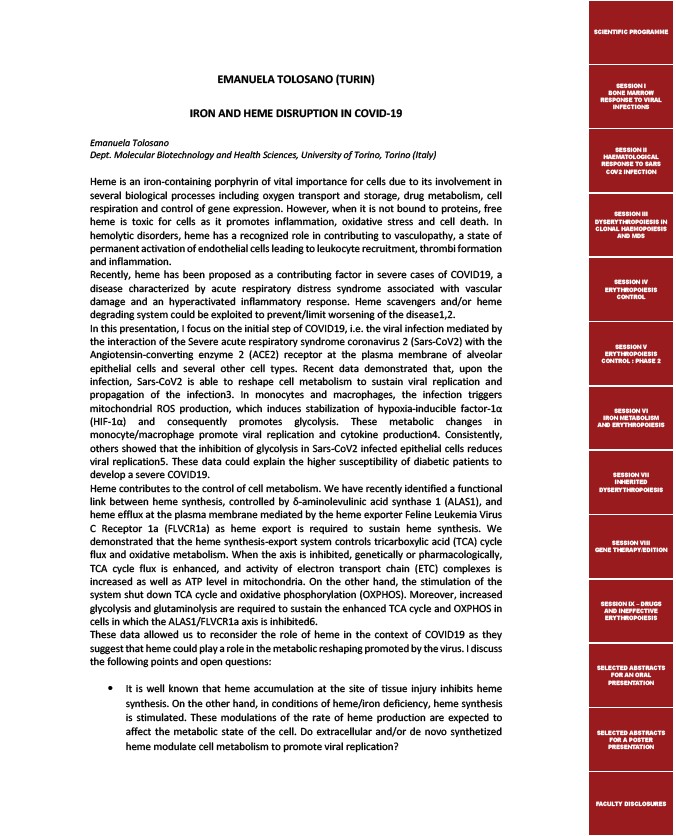
EMANUELA TOLOSANO (TURIN)
IRON AND HEME DISRUPTION IN COVID-19
Emanuela Tolosano
Dept. Molecular Biotechnology and Health Sciences, University of Torino, Torino (Italy)
Heme is an iron-containing porphyrin of vital importance for cells due to its involvement in
several biological processes including oxygen transport and storage, drug metabolism, cell
respiration and control of gene expression. However, when it is not bound to proteins, free
heme is toxic for cells as it promotes inflammation, oxidative stress and cell death. In
hemolytic disorders, heme has a recognized role in contributing to vasculopathy, a state of
permanent activation of endothelial cells leading to leukocyte recruitment, thrombi formation
and inflammation.
Recently, heme has been proposed as a contributing factor in severe cases of COVID19, a
disease characterized by acute respiratory distress syndrome associated with vascular
damage and an hyperactivated inflammatory response. Heme scavengers and/or heme
degrading system could be exploited to prevent/limit worsening of the disease1,2.
In this presentation, I focus on the initial step of COVID19, i.e. the viral infection mediated by
the interaction of the Severe acute respiratory syndrome coronavirus 2 (Sars-CoV2) with the
Angiotensin-converting enzyme 2 (ACE2) receptor at the plasma membrane of alveolar
epithelial cells and several other cell types. Recent data demonstrated that, upon the
infection, Sars-CoV2 is able to reshape cell metabolism to sustain viral replication and
propagation of the infection3. In monocytes and macrophages, the infection triggers
mitochondrial ROS production, which induces stabilization of hypoxia-inducible factor-1α
(HIF-1α) and consequently promotes glycolysis. These metabolic changes in
monocyte/macrophage promote viral replication and cytokine production4. Consistently,
others showed that the inhibition of glycolysis in Sars-CoV2 infected epithelial cells reduces
viral replication5. These data could explain the higher susceptibility of diabetic patients to
develop a severe COVID19.
Heme contributes to the control of cell metabolism. We have recently identified a functional
link between heme synthesis, controlled by δ-aminolevulinic acid synthase 1 (ALAS1), and
heme efflux at the plasma membrane mediated by the heme exporter Feline Leukemia Virus
C Receptor 1a (FLVCR1a) as heme export is required to sustain heme synthesis. We
demonstrated that the heme synthesis-export system controls tricarboxylic acid (TCA) cycle
flux and oxidative metabolism. When the axis is inhibited, genetically or pharmacologically,
TCA cycle flux is enhanced, and activity of electron transport chain (ETC) complexes is
increased as well as ATP level in mitochondria. On the other hand, the stimulation of the
system shut down TCA cycle and oxidative phosphorylation (OXPHOS). Moreover, increased
glycolysis and glutaminolysis are required to sustain the enhanced TCA cycle and OXPHOS in
cells in which the ALAS1/FLVCR1a axis is inhibited6.
These data allowed us to reconsider the role of heme in the context of COVID19 as they
suggest that heme could play a role in the metabolic reshaping promoted by the virus. I discuss
the following points and open questions:
• It is well known that heme accumulation at the site of tissue injury inhibits heme
synthesis. On the other hand, in conditions of heme/iron deficiency, heme synthesis
is stimulated. These modulations of the rate of heme production are expected to
affect the metabolic state of the cell. Do extracellular and/or de novo synthetized
heme modulate cell metabolism to promote viral replication?
SCIENTIFIC PROGRAMME
SESSION I
BONE MARROW
RESPONSE TO VIRAL
INFECTIONS
SESSION II
HAEMATOLOGICAL
RESPONSE TO SARS
COV2 INFECTION
SESSION III
DYSERYTHROPOIESIS IN
CLONAL HAEMOPOIESIS
AND MDS
SESSION IV
ERYTHROPOIESIS
CONTROL
SESSION V
ERYTHROPOIESIS
CONTROL : PHASE 2
SESSION VI
IRON METABOLISM
AND ERYTHROPOIESIS
SESSION VII
INHERITED
DYSERYTHROPOIESIS
SESSION VIII
GENE THERAPY/EDITION
SESSION IX – DRUGS
AND INEFFECTIVE
ERYTHROPOIESIS
SELECTED ABSTRACTS
FOR AN ORAL
PRESENTATION
SELECTED ABSTRACTS
FOR A POSTER
PRESENTATION
FACULTY DISCLOSURES